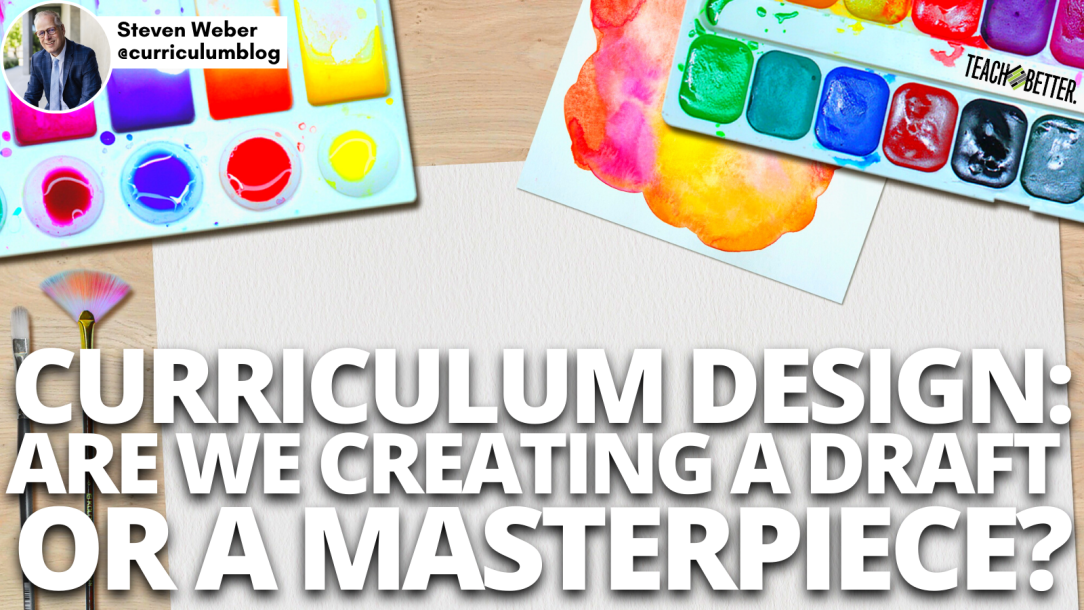TL;DR:
- Effective curriculum design teams don’t view their work as a masterpiece but as a draft.
- Having a draft allows room for reflection, feedback, and modifications to improve the curriculum.
Curriculum design teams are often torn between creating a draft document or a masterpiece. Teacher leaders are typically perfectionists, and they strive to create a masterpiece before sharing the curriculum with their colleagues across the school district. According to Linda Darling-Hammond (2010-2011), “A quality curriculum alters a student’s academic trajectory; it is a more powerful determinant of eventual achievement than their academic readiness when they enter school” (p. 23). Some curriculum design teams may infer that a ‘quality curriculum’ is a masterpiece. Why would teachers want to aim for less than a quality curriculum? There are several reasons why educators should resist the myth of a curriculum masterpiece.
A draft is a work in progress that allows the curriculum design team to communicate to all school staff that the draft is open for feedback, revision, and improvement following the taught and assessed curriculum. Click To TweetThe Myth of a Curriculum Masterpiece
- No curriculum is perfect.
- The written curriculum cannot be evaluated until it is taught to students.
- Vertical and horizontal alignment cannot be fully analyzed until the written curriculum and the taught curriculum are assessed.
- Following curriculum implementation, teacher teams may have suggestions for improving the written curriculum.
- A curriculum that cannot be revised for five years may not remain relevant to learners.
- Assuming that a curriculum is a masterpiece is akin to predicting your team will win the Final Four before you compete in the regular season and the tournament.
The Benefits of a Draft Curriculum
- A draft curriculum provides the curriculum design team with grace and room to adapt.
- A draft curriculum communicates to school staff that the implementation process will respect the feedback of teachers and administrators.
- Having a draft curriculum allows teachers to continue to add teacher-created resources, support documents, and alignment to the needs of learners.
- A draft curriculum allows teachers and administrators to bring the written, taught, and assessed curriculum into closer alignment.
- Having a draft curriculum allows teachers and curriculum design teams to insert key skills, learning targets, and resources that were omitted.
- A draft curriculum allows curriculum design teams to maintain a timely curriculum in real time.
Curriculum Design Is Complex
Curriculum design teams face several challenges, including the task of writing a K-12, vertically aligned curriculum. We live in a rapidly changing world. The curriculum may be outdated before it is taught. When teachers from multiple schools design a district curriculum, the task becomes more complex. According to Hale (2008), curriculum development is “an ongoing process that asks teachers and administrators to think, act, and meet differently to improve their students’ learning” (p. 8). One common failure with curriculum design is when district leaders focus on creating a masterpiece, rather than an ongoing process. “Nothing is a masterpiece – a real masterpiece – till it’s about two hundred years old. A picture is like a tree or a church, you’ve got to let it grow into a masterpiece” (Cary, 1944).
Implementing the Curriculum
Implementation may seem obvious. However, implementation is one of the most difficult steps in curriculum design. Instructional leaders cannot send an email to teachers and hope each teacher implements a well-designed plan. One of the barriers to curriculum implementation is the lack of an implementation plan. Leaders spend so much time and energy on the curriculum design plan that they fail to develop an implementation plan. The implementation plan should include teacher reflection, feedback, and curriculum revision opportunities.
Questions During Curriculum Implementation
- What are the strengths of the written curriculum (by unit)?
- What are the weaknesses of the written curriculum (by unit)?
- Is there anything missing from the unit?
- Which resources would you add to the written curriculum or support document?
- What evidence does your team or department have that indicates students have demonstrated growth and achievement of the learning goals outlined in this unit?
- Please share any other recommendations for the Curriculum Design Team.
An Artist Knows When to Revisit the Canvas
When curriculum design teams create a draft, they think like an artist. All curriculum or units will require revision at some point. Second and third drafts may only be needed by one grade-level team. But students will not have a strong foundation if the first-grade team assumes that the original curriculum was a masterpiece. School-level teams who begin with a curriculum draft will have the opportunity to:
- Envision the artwork (unit planning)
- Determine the right tools and process (taught curriculum)
- Reflect (assessed curriculum)
- Assess the return on investment (assessed curriculum)
- Make recommendations to the curriculum design team (curriculum revision as needed)
- Support students (acceleration and interventions)
- Assess the strengths and weaknesses of the draft curriculum (reflection and revision)
Are We Creating a Draft or a Masterpiece?
“The ultimate validation of a curriculum lies in its results; that is, did it help students achieve the desired outcomes?” (Wiggins & McTighe, 2007, p. 159). When curriculum design teams attempt to create a masterpiece, they are ignoring the importance of the implementation process. Designing a masterpiece that could be framed and archived in a museum may sound like a better product than a “draft curriculum.” A draft is a work in progress that allows the curriculum design team to communicate to all school staff that the draft is open for feedback, revision, and improvement following the taught and assessed curriculum.
The idea of a curriculum masterpiece is a futile pursuit. Curriculum documents in 1950 may have been designed for display in a museum, but that is no longer necessary with technology and the ability to revise the original draft. The next time your curriculum design team struggles over creating a draft or a masterpiece, reflect on the need for clarity, coherence, and collective efficacy. Aiming for a masterpiece may be an unrealistic goal for curriculum design teams.
References
Cary, J. (1944). The horse’s mouth. Michael Joseph.
Darling-Hammond, L. (2010-2011). Soaring systems. American Educator, 34(4). 20-23.
Hale, J.A. (2008). A guide to curriculum mapping: Planning, implementing, and sustaining the process. Corwin Press.
Wiggins, G. & McTighe, J. (2007). Schooling by design. ASCD.
About Steven Weber
Dr. Steven Weber is a curriculum leader. He has served on multiple state and national boards. His areas of research include curriculum design, multiplying leaders, professional learning, and school leadership.




